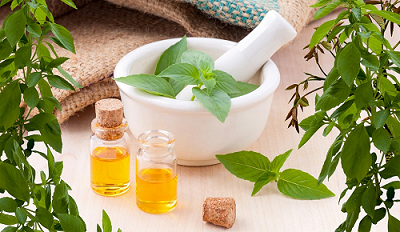
For centuries, the Chinese and Indians have used herbs to cure ailments. Today, science allows us to make the herbal extracts too. They are the liquid form sourced from specific plant parts, like roots, leaves, flowers, seeds, or bark, and they provide many medicinal benefits.
While most herbal extracts are sourced from plants, sometimes they come from non-plants, such as fungi and algae. What all herbal medicines have in common are bioactive compounds, also known as ‘phytochemicals’, which give herbs their healing properties.
Table of Contents
What are phytochemicals?
Phytochemicals are the reason why herbs, herbal medicines, and herbal extracts have therapeutic benefits. Phytochemicals are found naturally in different parts of plants. For example, Ashwagandha is extracted from the root, Lavender and Chamomile is located in the flowers, flax oil in the seeds, and California Poppy is the whole plant (Herb Pharm).
Many Indians love cooking with herbs and spices, as well as growing herbs at home. Not only do they add flavour to your meals, but they also provide many health benefits. Here are five culinary herbs and their essential bio-active ingredients.
5 Culinary herbs and why they are medicinal
Most of you will find these wonderfully healthy herbs right in your kitchen!
Ginger (root)
First used by the ancient Chinese and Indians, the famous spice has a long history of use in traditional or alternative medicine, especially against infections and inflammation.
Gingerol, the bioactive substance in fresh ginger can help lower the risk of infections and fight off respiratory viral infections. Recent studies show that ginger extract has chemopreventive and antineoplastic properties in gastric cancer, particularly the phytochemical 6-gingerol. The main active ingredients in ginger are 6-gingerol, 6-shogaol, and 6-paradol (Hindwai).
Garlic (cloves, root)
Garlic is excellent for controlling high cholesterol and blood pressure, thanks to flavonoids and sulphur-containing compounds. Garlic has antimicrobial effects and researchers are studying the possibility that it may prevent cancer. The FDA considers garlic safe, but it should not be consumed with blood thinners, or before an operation. This is because large amounts of garlic may affect clotting (URMC).
Turmeric (root)
This is another root from the ginger family. Curcumin is the powerful antioxidant in turmeric, that boosts the body’s immunity and natural antioxidants. It relieves many ailments mostly caused by inflammation, ranging from digestive problems to arthritis.
Cinnamon (bark)
The spice is made from the inner bark of trees and has some powerful medicinal properties. The notable phytochemicals in it are cinnamaldehyde and phenolics. Cinnamaldehyde keeps the body’s fat and cholesterol levels in check, while phenolics support insulin and blood sugar levels (Gaia Herbs).
Rosemary (leaf)
Rosmarinic Acid is the active ingredient present in Rosemary leaves. It helps suppress allergies and nasal congestion.m
What about rare herbs?
People grow herb gardens all the time. You too can grow your own medicinal herb garden. Find out how to grow medicinal herbs like Echinacea, Southern Ginseng, Calendula, Tulsi, Passionflower, and more in your back yard here.
Besides those in your grocery store, garden, terrace, and footpath, there are non-plant based herbs, like Reishi mushroom and Bladderwrack algae (Herb Pharm).
In fact, there are too many herbs to list them all here!
Download a list of herbal extracts, categorised by botanical name, common name, and actives here. If you are looking for a full reference dictionary of Indian Medicinal Plants, download this guide.
Why use herbal liquid extracts, instead of raw herbs?
The answer is simple: Liquid herbal extracts are much more easily absorbed than solids.
This is the primary reason why herbalists recommend extracts. There is no pressure on the digestive system because you are not eating anything. Your body can easily absorb essential phytochemicals present in the herbal extracts when they are in liquid form.
Also, liquid extracts are usually fresher, compared to the dried and ground-up powder. Herbal liquid extracts and soft gels usually last longer because alcohol is an excellent preservative, retaining their potency even after 5 years. They also provide full-strength potency up to five times longer than capsules do (Herb Pharm).
How to use herbals extracts
Using herbal extracts is so simple!
Most people use extracts because they are less bothersome than eating raw herbs, and they are convenient. Most herbal extracts come packaged with an easy-to-use dropper on the top. Consume it alone, or diluted with a glass of water or your favourite juice (Vitavibes).
A word of caution:
Remember that just because a product is “natural”, it does not automatically mean it is “safe” for everyone. Therefore, you must inform your doctors about any herb or dietary supplement before you start using it, and find out if they react with other supplements and medications you are using.
How to make herbal extracts
This is a good question, for which there is no single answer. Herbal product manufacturers have their own method of extracting plant medicine. Some manufacturers use highly scientific methods of standardization that involve more exact measurements. Others use the traditional “whole herb” school of thought. Here the belief is that the entire plant contributes to the healing process, so plucking out a few compounds might mean losing that synergy (Mother Earth Living).
For liquid extracts (aka tinctures)
When the whole herb is soaked in a mixture of water and alcohol, the solution pulls crucial plant chemicals out of the herb, while also acting as a preservative (Vital Plan).
For powdered extracts
First, the raw herbs are soaked in the solvent and later evaporated, often under vacuum to obtain the powdered extract. Powdered extracts are made into finished products as capsules and tablets, which are packaged as herbal supplements (Vital Plan).
What solvent is used?
Typically, herbal extracts are classified depending on the type of solvent used to make them. Typical solvents include alcohols, glycerine, vinegar, and of course, water. The phytochemical extracted in any particular herb will vary with the solvent used.
Water also dissolves in organic solvents. Some of the best solvents are aqueous solutions of ethanol, methanol, acetone, and ethyl acetate. In chemistry, there is a rule “like dissolves like”. Therefore, organic phytochemicals are easy to extract in organic solvents like ethanol, methanol, and acetone. Sometimes, water by itself is an excellent solvent. For example, tea infusions and decoctions are watery extracts. So are rinses and syrups.
What is herbalism?
The study of medicinal plants and herbs and their extracts is known as herbalism. The scientists who study them are called herbalists. Clinical or medical herbalists advise their clients on how to use herbs based on scientific research. Many herbalists practice herbalism with a focus on traditional and historical herbal remedies for better well-being.
Alternative medicine or holistic healing also rely on herbal therapy. Ayurveda, traditional Chinese herbal medicine, acupuncture, naturopathy, osteopathy, and aromatherapy use a variety of herbs for the treatment of diseases and common ailments (Herb Pharm).
What is the difference between Ayurveda and herbal medicine?
Herbal medicine is mainly plant-based. It uses herbs, herbal extracts for curing ailments. Ayurveda is a centuries-old natural Indian therapy, which combines medicinal plant extracts as well as metal extractions, massage therapy, and more.
Which countries export herbal extracts?
India is second only to China as the world’s largest exporter of herbal medicines. China and India together produce over 70% of the global demand. China exports the natural form of the bulk herbs (leaves, dry fruits, flowers, seeds, and roots) as well as the extracts. Anzen Exports imports the raw Chinese herbs as well as the herbal extracts from suppliers in China.
For more product information about different Herbal Extracts in India, as well as Pharmaceutical (APIs), Nutraceutical and Cosmetic Ingredients, contact Anzen Exports.
Disclaimer:
Anzen Exports’ blog posts are based just on our research from cited websites. To be best informed, we advise consulting a doctor about an ingredient or medicine prior to taking it.
References:
“How to use Liquid Herbal Extracts.” Discount Vitamins, Supplements, Health Foods & More | Vitacost, 3 Feb. 2010, www.vitacost.com/blog/vitamins-supplements/supplements/how-to-use-liquid-herbal-extracts.html.
“Are There Different Types of Herbalists?” Herb Pharm, 21 Jan. 2020, www.herb-pharm.com/pharm-journal/ask-an-herbalist-types-of-herbalists/.
“Cinnamon.” Gaia Herbs, 6 Oct. 2018, www.gaiaherbs.com/blogs/herbs/cinnamon.
“A Guide to Common Medicinal Herbs – Health Encyclopedia – University of Rochester Medical Center.” Welcome to URMC – Rochester, NY – University of Rochester Medical Center, www.urmc.rochester.edu/encyclopedia/content.aspx?contenttypeid=1&contentid=1169.
“Plant Medicine: Herbal Extraction Methods.” Mother Earth Living, Oct. 1998, www.motherearthliving.com/health-and-wellness/herbal-extracts.
“What Makes a Plant an Herb?” Herb Pharm, 21 Jan. 2020, www.herb-pharm.com/pharm-journal/what-makes-a-plant-an-herb/.
“Whole Herb Vs. Herbal Extract: Which is Better?” Vital Plan | The Power of Nature in Your Hands, 30 May 2019, vitalplan.com/blog/whole-herb-vs-herbal-extract-which-is-better.
